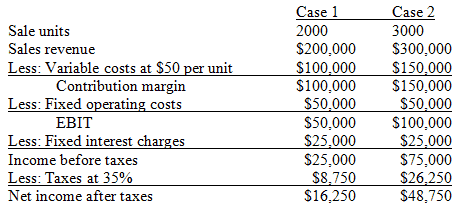Combined Leverage - Capital Structure, Accountancy and Financial Management | Accountancy and Financial Management - B Com PDF Download
Combined Leverage
When the company uses both financial and operating leverage to magnification of any change in sales into a larger relative changes in earning per share. Combined leverage is also called as composite leverage or total leverage.
Combined leverage express the relationship between the revenue in the account of sales and the taxable income.
Combined leverage can be calculated with the help of the following formulas:

Where,
CL = Combined Leverage
OL = Operating Leverage
FL = Financial Leverage
C = Contribution
OP = Operating Profit (EBIT)
PBT = Profit Before Tax
Degree of Combined Leverage
The percentage change in a firm’s earning per share (EPS) results from one percent change in sales. This is also equal to the firm’s degree of operating leverage (DOL) times its degree of financial leverage (DFL) at a particular level of sales.
Degree of contributed coverage = Percentage change in EPS/Percentage change in sales
Formula
Combined leverage, as the name implies shows the total effect of the operating and financial leverages. In other words, combined leverage shows the total risks associated with the firm. It is the product of both the leverages.
Degree of Combined Leverage (DOL) = DOL * DFL
Example 1:
Kumar company has sales of Rs. 25,00,000. Variable cost of Rs. 12,50,000 and fixed cost of Rs. 50,000 and debt of Rs. 12,50,000 at 8% rate of interest. Calculate combined leverage.
Solution:
Sales | 25,00,000 |
Less: Variable cost | 15,00,000 |
Contribution | 10,00,000 |
Less: Fixed cost | 5,00,000 |
Operating Profit | 5,00,000 |
Combined leverage = Operating leverage x Financial leverage
Calculation of financial leverage
Contribution/Operating Profit = 10,00,000/5,00,000 = 2
Calculation of financial leverage
Earning before Interest and Tax (EBIT) | 5,00,000 |
Less: Interest on Debenture ( 8% of 12,50,000) | 1,00,000 |
Earnings before Tax | 4,00,000 |
Operating leverage= Operating Profit /Earning Before Tax = 5,00,000/4,00,000 = 1.25
Combined leverage = 2 x 1.25 = 2.5
Example 2 :
Calculate the operating, financial and combined leverage under situations 1 and 2 and the financial plans for X and Y respectively from the following information relating to the operating and capital structure of a company, and also find out which gives the highest and the least value ? Installed capacity is 5000 units. Annual Production and sales at 60% of installed capacity.
Selling price per unit Rs. 25
Variable cost per unit Rs. 15
Fixed cost:
Situation 1 : Rs. 10,000
Situation 2 : Rs. 12,000
Capital structure:


Solution.
Annual production and sales 60% of 5,000 = 3000 Unit
Contribution per Unit | Rs. |
Selling Price | 25 Per Unit |
Variable Price | 15 Per Unit |
| 10 Per Unit |
Total contribution is 3000 Units x Rs. 10 = Rs. 30,000
Computation of leverage.
Example 3:
A firm selling price of its product is $100 per unit. The variable cost per unit is $50 and the fixed operating costs are $50,000 per year. The fixed interest expenses (non-operating) are $25,000 and the firm has 10,000 shares outstanding. Let us evaluate the combined leverage resulting from sale of 1) 2000 units & 2) 3000 units. Tax rate = 35%.
Solution.

Percentage change in EPS = ($4.875 - $1.625)/$1.625 x 100 → 200%
Percentage change in Sales = ($300,000 - $200,000)/$200,000 x 100 → 50%
DCL = 200%/50% → 4
A combined leverage (total risk) of 4 indicates that for every $1 change in sales, there would be a $4 change in the Earnings per share in either direction.
|
44 videos|75 docs|18 tests
|
FAQs on Combined Leverage - Capital Structure, Accountancy and Financial Management - Accountancy and Financial Management - B Com
| 1. What is combined leverage in capital structure? |  |
| 2. How is combined leverage calculated? |  |
| 3. What is the difference between operating leverage and financial leverage? |  |
| 4. How does combined leverage affect a company's risk and return? |  |
| 5. How can a company manage its combined leverage? |  |






















